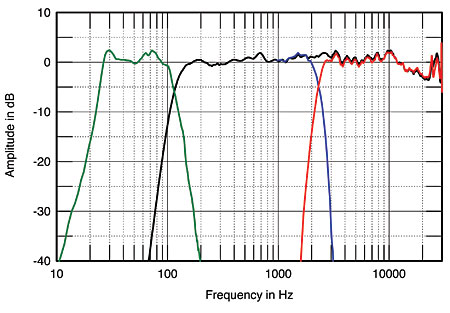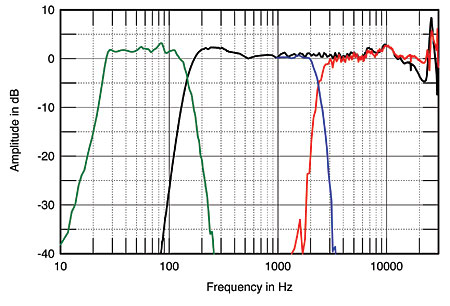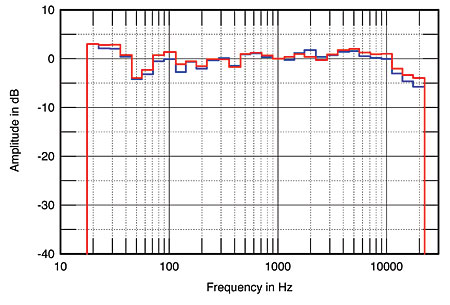| Columns Retired Columns & Blogs |
NHT Xd active loudspeaker system Follow-Up Measurements
Sidebar: Follow-Up Measurements
Fig.1 shows the response of the Xd satellite (black trace) and the XdW subwoofer (green), as well as the individual responses of the Xd tweeter (red) and woofer (blue), with the XdA crossover running the original digital filters. The crossover points lie at 110Hz and 2.3kHz, and the Linkwitz-Riley filter slopes are a very steep 48dB/octave. A touch of excess energy can be seen in the mid-treble, and the top octave is a little shelved off both on axis (red) and in the 30° averaged response (black). It also looks as if the tweeter's ultrasonic dome resonance has been notched out.

Fig.1 NHT Xd system, original XdA crossover filters, anechoic response on axis at 50", averaged across 30° horizontal window and corrected for microphone response (black), with the nearfield XdS woofer (black) and XdW subwoofer (green) responses plotted below 300Hz, and the individual XdS woofer (blue) and tweeter (red) responses.
By contrast, fig.2 shows a similar set of response curves taken with the revised filters (NHT's "150Hzcrossover.flt" file). (Because of continued wind and torrential rain during October 2005, the responses above 300Hz were taken indoors at 40" instead of outdoors at 50"; this affects the accuracy of the measurements in the midrange but is otherwise inconsequential.) The filter slopes are still 48dB/octave, and the crossover between the XdW subwoofer and the XdS satellite can be seen to have been shifted up to 150Hz, as specified. While the upper crossover point looks very similar to that in fig.1, the XdS drivers look better integrated overall, with a flatter mid-treble. There is also now slightly more energy apparent between 7kHz and 15kHz, and the tweeter's ultrasonic resonance is unfettered by a notch. The response on-axis (red trace) now extends flat to the tweeter's resonance at 27kHz, though the HF unit's limited dispersion above 15kHz results in less energy in this region in the 30°-averaged curve (black).

Fig.2 NHT Xd system, revised XdA crossover filters, anechoic response on axis at 50", averaged across 30° horizontal window and corrected for microphone response (black), with the nearfield XdS woofer (black) and XdW subwoofer (green) responses plotted below 300Hz, and the individual XdS woofer (blue) and tweeter (red) responses.
But it is the response in the room that matters most. To investigate how the Xd system behaved in my listening room, I ran my usual test of averaging 120 1/3-octave power spectra taken individually for the left and right speakers in a window centered on the position of my ears. The blue trace in fig.3 shows the in-room response of the Xd system with dual subwoofers and the XdA's original digital filters. The lack of energy in the 50Hz and 63Hz bands is endemic to my room and seating position. But note the extension to 20Hz and the very flat midrange, meeting ±1dB limits from 250Hz to 16kHz—superb performance for an in-room, listening-position measurement. There is a slight lack of upper-bass energy, though not nearly as much as I was expecting from my auditioning.

Fig.3 NHT Xd system, 1/3-octave, spatially averaged response in JA's listening room with original crossover filters (blue) and revised crossover filters (red).
The red trace in fig.3 is the in-room response taken in an identical manner with the 150Hz crossover/EQ. Overall it looks very similar, but there are detail differences that correlate with the listening impressions. There is more energy in the 80Hz, 100Hz, and 125Hz bands, indicating better integration between the subwoofers and satellites. That slight bump at 2kHz is gone, and the top two octaves are between 1–3dB higher in level. The response now falls between ±1.25dB limits all the way from 80Hz to 16kHz, which is simply extraordinary in-room performance. Extraordinary!—John Atkinson
- Log in or register to post comments




































